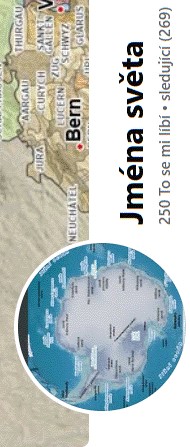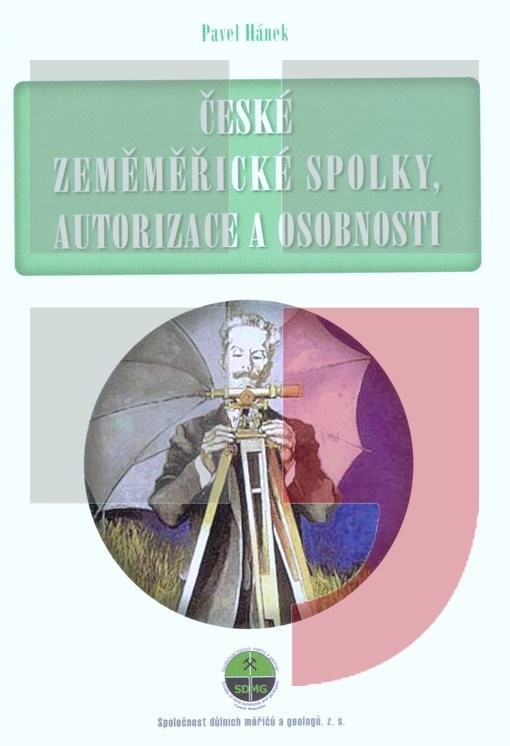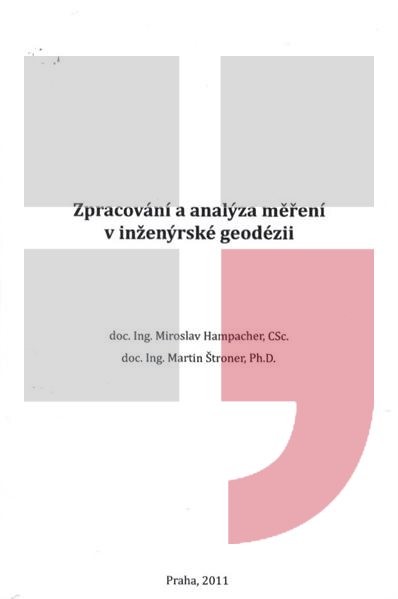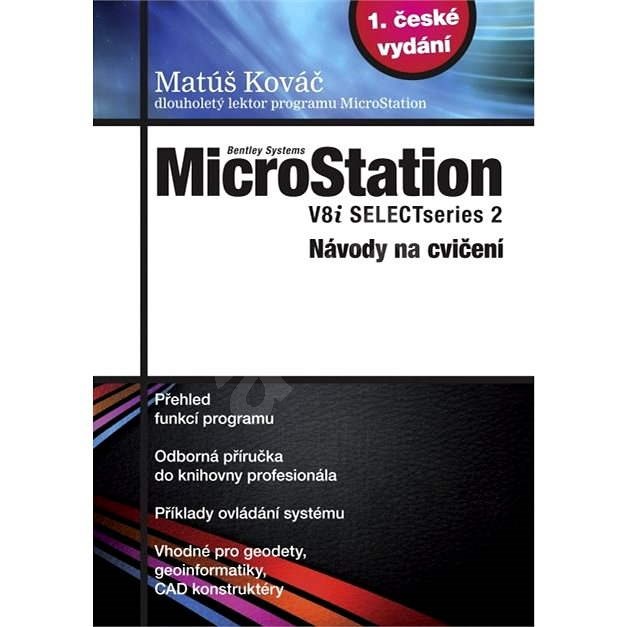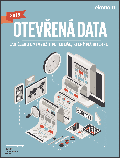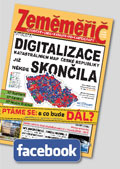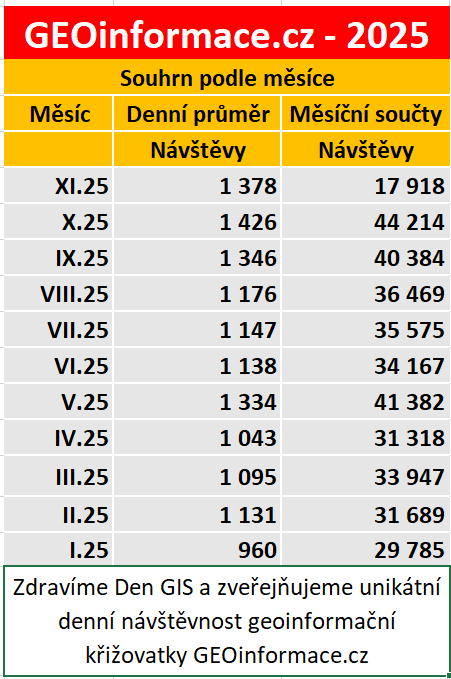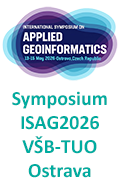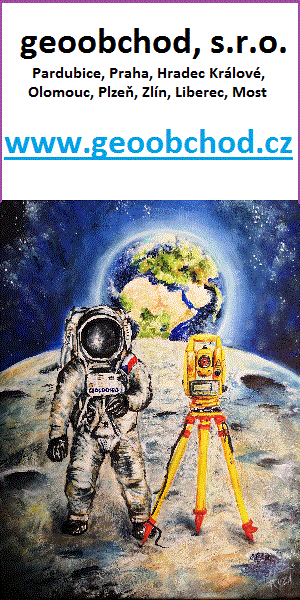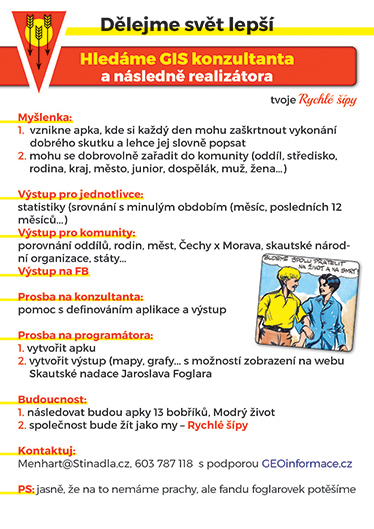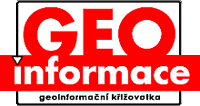zprávy
zdroje zpráv:ÚPRAVA ÚŘEDNÍCH HODIN
9.10.2020 17:28 ČÚZK - předpisy a opatření Katastrální úřad pro Olomoucký kraj zveřejnil novou aktualitu: ÚPRAVA ÚŘEDNÍCH HODINS ohledem na opatření přijatá usnesením vlády ČR č. 994 ze dne 8. října 2020
v období od pondělí 12. října 2020 do pátku 23. října 2020
upravujeme úřední hodiny na všech katastrálních pracovištích v působnosti KÚ pro Olomoucký kraj
na pondělí a středu 8:00 až 13:00 hodin.
Podrobné informace jsou uvedeny v přiloženém dokumentu (PDF).
Děkujeme za pochopení.
ÚPRAVA ÚŘEDNÍCH HODIN
9.10.2020 17:28 ČÚZK - předpisy a opatření Katastrální úřad pro Olomoucký kraj zveřejnil novou aktualitu: ÚPRAVA ÚŘEDNÍCH HODINS ohledem na opatření přijatá usnesením vlády ČR č. 994 ze dne 8. října 2020
v období od pondělí 12. října 2020 do pátku 23. října 2020
upravujeme úřední hodiny na všech katastrálních pracovištích v působnosti KÚ pro Olomoucký kraj
na pondělí a středu 8:00 až 13:00 hodin.
Podrobnější informace o styku úřadu s veřejností, podání, poskytování informací a způsobu placení poplatků
naleznete zde
Děkujeme za pochopení.
ÚPRAVA ÚŘEDNÍCH HODIN
9.10.2020 17:28 ČÚZK /Urady/Katastralni-urady/Katastralni-urady/Katastralni-urad-pro-Olomoucky-kraj/O-uradu/Aktuality/UPRAVA-UREDNICH-HODINJoint Statement Between Velodyne and RoboSense
9.10.2020 16:43 GISCafe.com Webcasts-Webinars SAN JOSE, Calif. — (BUSINESS WIRE) — October 8, 2020 —Velodyne Lidar, Inc. (NASDAQ: VLDR, VLDRW) and RoboSense (Suteng Innovation …
Woolpert Establishes UAS Hub, Adds Office at Aviation Research Park in New Jersey
9.10.2020 16:43 GISCafe.com Webcasts-Webinars The Egg Harbor Township site is next to the FAA technical center and the Atlantic City International Airport.EGG HARBOR TOWNSHIP, N.J., Oct. 9, 2020 …
Oznámení o omezeném provozu katastrálních pracovišť Katastrálního úřadu pro Jihočeský kraj
9.10.2020 14:58 ČÚZK - předpisy a opatření Katastrální úřad pro Jihočeský kraj zveřejnil novou aktualitu: Oznámení o omezeném provozu katastrálních pracovišť Katastrálního úřadu pro Jihočeský kraj v období od 12. do 25. října 2020Oznámení o omezeném provozu katastrálních pracovišť Katastrálního úřadu pro Jihočeský kraj
9.10.2020 14:58 ČÚZK - předpisy a opatření Katastrální úřad pro Jihočeský kraj zveřejnil novou aktualitu: Oznámení o omezeném provozu katastrálních pracovišť Katastrálního úřadu pro Jihočeský kraj v období od 12. do 25. října 2020Oznámení o omezeném provozu katastrálních pracovišť Katastrálního úřadu pro Jihočeský kraj
9.10.2020 14:58 ČÚZK /Urady/Katastralni-urady/Katastralni-urady/Katastralni-urad-pro-Jihocesky-kraj/O-uradu/Aktuality/Oznameni-o-omezenem-provozu-katastralnich-pracovisGlobal lake warming trend threatens freshwater species
9.10.2020 14:33 ESA Observing the Earth
Holding over 80% of Earth’s surface freshwater, lakes support and sustain communities across the planet. A new study uses satellite data to underline the vulnerability of these inland water bodies to climate change and warns of serious future consequences for many freshwater species worldwide.
20201009_omezení služeb
9.10.2020 14:22 ČÚZK - předpisy a opatření Katastrální úřad pro Středočeský kraj 20201009 - omezení chodu úřadu Upozornění Katastrálního úřadu!Od 12.10.2020 dochází na Katastrálním úřadu pro Středočeský kraj k omezení služeb pro veřejnost.
Podrobné informace o změně úředních hodin jsou uvedeny v přiloženém dokumentu (PDF)
Děkujeme za pochopení.
20201009_omezení služeb
9.10.2020 14:22 ČÚZK /Urady/Katastralni-urady/Katastralni-urady/Katastralni-urad-pro-Stredocesky-kraj/O-uradu/Aktuality/20201009_omezeni-sluzeb20201009_omezení služeb
9.10.2020 14:22 ČÚZK - předpisy a opatření Katastrální úřad pro Středočeský kraj 20201009 - omezení chodu úřadu Upozornění Katastrálního úřadu!Od 12.10.2020 dochází na Katastrálním úřadu pro Středočeský kraj k omezení služeb pro veřejnost.
Více informací: ODKAZ
Děkujeme za pochopení.
20201009_omezení služeb
9.10.2020 14:22 ČÚZK - předpisy a opatření Katastrální úřad pro Středočeský kraj 20201009 - omezení chodu úřadu Upozornění Katastrálního úřadu!Od 12.10.2020 dochází na Katastrálním úřadu pro Středočeský kraj k omezení služeb pro veřejnost.
Více informací: ODKAZ
Děkujeme za pochopení.
20201009_omezení služeb
9.10.2020 14:22 ČÚZK - předpisy a opatření Katastrální úřad pro Středočeský kraj 20201009 - omezení chodu úřadu Upozornění Katastrálního úřadu!Od 12.10.2020 dochází na Katastrálním úřadu pro Středočeský kraj k omezení služeb pro veřejnost.
Podrobné informace o změně úředních hodin jsou uvedeny v přiloženém dokumentu (PDF)
Děkujeme za pochopení.
Schránka pro vhození podání
9.10.2020 14:17 ČÚZK - předpisy a opatření Katastrální úřad pro Liberecký kraj - Katastrální pracoviště Česká Lípa zveřejnil novou aktualitu:Vážení klienti,
v zádveří budovy Katastrálního pracoviště Česká Lípa je umístěna schránka, do které lze v zalepené obálce vhazovat podání určené katastrálnímu úřadu (návrhy na zápis práv a jiných údajů do katastru), a to i mimo v nouzovém režimu stanovené úřední hodiny.
Schránka je přístupná takto: pondělí a středa od 8 do 17 hodin, úterý a čtvrtek od 8 do 14 hodin, pátek od 8 do 12 hodin. Schránka se vybírá každou celou hodinu, počínaje 9 hodinou. Potvrzení o přijetí podání (včetně skenu první stránky návrhu na vklad s otiskem podacího razítka v případě podání návrhu na vklad), obdržíte na e-mail, který prosím uvádějte v návrhu (podání). Na tento e-mail Vám bude zaslán podklad pro platbu (v případě, že je podání návrhu zpoplatněno) tak, abyste mohli provést platbu bezhotovostně prostřednictvím Vaší banky.
Vzhledem k tomu, že schránka je umístěna v zádveří vstupu do budovy, není zde možnost vyplnění návrhu na vklad a ani zde nejsou umístěny formuláře návrhu na vklad tak, jako na podatelně, a to z důvodu, aby se v prostoru nikdo nezdržoval delší dobu. Pokud potřebujete vyplnit návrh na vklad, případně jiný formulář, využijte prosím zejména elektronickou aplikaci na adrese: https://www.cuzk.cz/Fornulare-a-elektronicka-podani resp. na adrese: https://nv.cuzk.cz/Web/Uvod.aspx.
Prosíme, nevhazujte v obálce hotovost, platbu zaplaťte bezhotovostně na výzvu resp. podklad pro platbu, který Vám bude zaslán na e-mail!
Děkujeme za pochopení.
Schránka je přístupná takto: pondělí a středa od 8 do 17 hodin, úterý a čtvrtek od 8 do 14 hodin, pátek od 8 do 12 hodin. Schránka se vybírá každou celou hodinu, počínaje 9 hodinou. Potvrzení o přijetí podání (včetně skenu první stránky návrhu na vklad s otiskem podacího razítka v případě podání návrhu na vklad), obdržíte na e-mail, který prosím uvádějte v návrhu (podání). Na tento e-mail Vám bude zaslán podklad pro platbu (v případě, že je podání návrhu zpoplatněno) tak, abyste mohli provést platbu bezhotovostně prostřednictvím Vaší banky.
Vzhledem k tomu, že schránka je umístěna v zádveří vstupu do budovy, není zde možnost vyplnění návrhu na vklad a ani zde nejsou umístěny formuláře návrhu na vklad tak, jako na podatelně, a to z důvodu, aby se v prostoru nikdo nezdržoval delší dobu. Pokud potřebujete vyplnit návrh na vklad, případně jiný formulář, využijte prosím zejména elektronickou aplikaci na adrese: https://www.cuzk.cz/Fornulare-a-elektronicka-podani resp. na adrese: https://nv.cuzk.cz/Web/Uvod.aspx.
Prosíme, nevhazujte v obálce hotovost, platbu zaplaťte bezhotovostně na výzvu resp. podklad pro platbu, který Vám bude zaslán na e-mail!
Děkujeme za pochopení.
Schránka pro vhození podání
9.10.2020 14:17 ČÚZK - předpisy a opatření Katastrální úřad pro Liberecký kraj - Katastrální pracoviště Česká Lípa zveřejnil novou aktualitu:Vážení klienti,
v zádveří budovy Katastrálního pracoviště Česká Lípa je umístěna schránka, do které lze v zalepené obálce vhazovat podání určené katastrálnímu úřadu (návrhy na zápis práv a jiných údajů do katastru), a to i mimo v nouzovém režimu stanovené úřední hodiny.
Schránka je přístupná takto: pondělí, úterý a čtvrtek od 8 do 14 hodin, středa od 8 do 17 hodin, pátek od 8 do 12 hodin. Schránka se vybírá každou celou hodinu, počínaje 9 hodinou. Potvrzení o přijetí podání (včetně skenu první stránky návrhu na vklad s otiskem podacího razítka v případě podání návrhu na vklad), obdržíte na e-mail, který prosím uvádějte v návrhu (podání). Na tento e-mail Vám bude zaslán podklad pro platbu (v případě, že je podání návrhu zpoplatněno) tak, abyste mohli provést platbu bezhotovostně prostřednictvím Vaší banky.
Vzhledem k tomu, že schránka je umístěna v zádveří vstupu do budovy, není zde možnost vyplnění návrhu na vklad a ani zde nejsou umístěny formuláře návrhu na vklad tak, jako na podatelně, a to z důvodu, aby se v prostoru nikdo nezdržoval delší dobu. Pokud potřebujete vyplnit návrh na vklad, případně jiný formulář, využijte prosím zejména elektronickou aplikaci na adrese: https://www.cuzk.cz/Fornulare-a-elektronicka-podani resp. na adrese: https://nv.cuzk.cz/Web/Uvod.aspx.
Prosíme, nevhazujte v obálce hotovost, platbu zaplaťte bezhotovostně na výzvu resp. podklad pro platbu, který Vám bude zaslán na e-mail!
Děkujeme za pochopení.
Schránka je přístupná takto: pondělí, úterý a čtvrtek od 8 do 14 hodin, středa od 8 do 17 hodin, pátek od 8 do 12 hodin. Schránka se vybírá každou celou hodinu, počínaje 9 hodinou. Potvrzení o přijetí podání (včetně skenu první stránky návrhu na vklad s otiskem podacího razítka v případě podání návrhu na vklad), obdržíte na e-mail, který prosím uvádějte v návrhu (podání). Na tento e-mail Vám bude zaslán podklad pro platbu (v případě, že je podání návrhu zpoplatněno) tak, abyste mohli provést platbu bezhotovostně prostřednictvím Vaší banky.
Vzhledem k tomu, že schránka je umístěna v zádveří vstupu do budovy, není zde možnost vyplnění návrhu na vklad a ani zde nejsou umístěny formuláře návrhu na vklad tak, jako na podatelně, a to z důvodu, aby se v prostoru nikdo nezdržoval delší dobu. Pokud potřebujete vyplnit návrh na vklad, případně jiný formulář, využijte prosím zejména elektronickou aplikaci na adrese: https://www.cuzk.cz/Fornulare-a-elektronicka-podani resp. na adrese: https://nv.cuzk.cz/Web/Uvod.aspx.
Prosíme, nevhazujte v obálce hotovost, platbu zaplaťte bezhotovostně na výzvu resp. podklad pro platbu, který Vám bude zaslán na e-mail!
Děkujeme za pochopení.
Schránka pro vhození podání
9.10.2020 14:17 ČÚZK - předpisy a opatření Katastrální úřad pro Liberecký kraj - Katastrální pracoviště Česká Lípa zveřejnil novou aktualitu:Vážení klienti,
v zádveří budovy Katastrálního pracoviště Česká Lípa je umístěna schránka, do které lze v zalepené obálce vhazovat podání určené katastrálnímu úřadu (návrhy na zápis práv a jiných údajů do katastru), a to i mimo v nouzovém režimu stanovené úřední hodiny.
Schránka je přístupná takto: pondělí a středa od 8 do 17 hodin, úterý a čtvrtek od 8 do 14 hodin, pátek od 8 do 12 hodin. Schránka se vybírá každou celou hodinu, počínaje 9 hodinou. Potvrzení o přijetí podání (včetně skenu první stránky návrhu na vklad s otiskem podacího razítka v případě podání návrhu na vklad), obdržíte na e-mail, který prosím uvádějte v návrhu (podání). Na tento e-mail Vám bude zaslán podklad pro platbu (v případě, že je podání návrhu zpoplatněno) tak, abyste mohli provést platbu bezhotovostně prostřednictvím Vaší banky.
Vzhledem k tomu, že schránka je umístěna v zádveří vstupu do budovy, není zde možnost vyplnění návrhu na vklad a ani zde nejsou umístěny formuláře návrhu na vklad tak, jako na podatelně, a to z důvodu, aby se v prostoru nikdo nezdržoval delší dobu. Pokud potřebujete vyplnit návrh na vklad, případně jiný formulář, využijte prosím zejména elektronickou aplikaci na adrese: https://www.cuzk.cz/Fornulare-a-elektronicka-podani resp. na adrese: https://nv.cuzk.cz/Web/Uvod.aspx.
Prosíme, nevhazujte v obálce hotovost, platbu zaplaťte bezhotovostně na výzvu resp. podklad pro platbu, který Vám bude zaslán na e-mail!
Děkujeme za pochopení.
Schránka je přístupná takto: pondělí a středa od 8 do 17 hodin, úterý a čtvrtek od 8 do 14 hodin, pátek od 8 do 12 hodin. Schránka se vybírá každou celou hodinu, počínaje 9 hodinou. Potvrzení o přijetí podání (včetně skenu první stránky návrhu na vklad s otiskem podacího razítka v případě podání návrhu na vklad), obdržíte na e-mail, který prosím uvádějte v návrhu (podání). Na tento e-mail Vám bude zaslán podklad pro platbu (v případě, že je podání návrhu zpoplatněno) tak, abyste mohli provést platbu bezhotovostně prostřednictvím Vaší banky.
Vzhledem k tomu, že schránka je umístěna v zádveří vstupu do budovy, není zde možnost vyplnění návrhu na vklad a ani zde nejsou umístěny formuláře návrhu na vklad tak, jako na podatelně, a to z důvodu, aby se v prostoru nikdo nezdržoval delší dobu. Pokud potřebujete vyplnit návrh na vklad, případně jiný formulář, využijte prosím zejména elektronickou aplikaci na adrese: https://www.cuzk.cz/Fornulare-a-elektronicka-podani resp. na adrese: https://nv.cuzk.cz/Web/Uvod.aspx.
Prosíme, nevhazujte v obálce hotovost, platbu zaplaťte bezhotovostně na výzvu resp. podklad pro platbu, který Vám bude zaslán na e-mail!
Děkujeme za pochopení.
Schránka pro vhození podání
9.10.2020 14:17 ČÚZK - předpisy a opatření Katastrální úřad pro Liberecký kraj - Katastrální pracoviště Česká Lípa zveřejnil novou aktualitu:Vážení klienti,
v zádveří budovy Katastrálního pracoviště Česká Lípa je umístěna schránka, do které lze v zalepené obálce vhazovat podání určené katastrálnímu úřadu (návrhy na zápis práv a jiných údajů do katastru), a to i mimo v nouzovém režimu stanovené úřední hodiny.
Schránka je přístupná a vybírá se každou celou hodinu takto: pondělí a středa od 8 do 17 hodin, úterý a čtvrtek od 8 do 14 hodin, pátek od 8 do 12 hodin. Potvrzení o přijetí podání (včetně skenu první stránky návrhu na vklad s otiskem podacího razítka v případě podání návrhu na vklad), obdržíte na e-mail, který prosím uvádějte v návrhu (podání). Na tento e-mail Vám bude zaslán podklad pro platbu (v případě, že je podání návrhu zpoplatněno) tak, abyste mohli provést platbu bezhotovostně prostřednictvím Vaší banky.
Vzhledem k tomu, že schránka je umístěna v zádveří vstupu do budovy, není zde možnost vyplnění návrhu na vklad a ani zde nejsou umístěny formuláře návrhu na vklad tak, jako na podatelně, a to z důvodu, aby se v prostoru nikdo nezdržoval delší dobu. Pokud potřebujete vyplnit návrh na vklad, případně jiný formulář, využijte prosím zejména elektronickou aplikaci na adrese: https://www.cuzk.cz/Fornulare-a-elektronicka-podani resp. na adrese: https://nv.cuzk.cz/Web/Uvod.aspx.
Prosíme, nevhazujte v obálce hotovost, platbu zaplaťte bezhotovostně na výzvu resp. podklad pro platbu, který Vám bude zaslán na e-mail!
Děkujeme za pochopení.
Schránka je přístupná a vybírá se každou celou hodinu takto: pondělí a středa od 8 do 17 hodin, úterý a čtvrtek od 8 do 14 hodin, pátek od 8 do 12 hodin. Potvrzení o přijetí podání (včetně skenu první stránky návrhu na vklad s otiskem podacího razítka v případě podání návrhu na vklad), obdržíte na e-mail, který prosím uvádějte v návrhu (podání). Na tento e-mail Vám bude zaslán podklad pro platbu (v případě, že je podání návrhu zpoplatněno) tak, abyste mohli provést platbu bezhotovostně prostřednictvím Vaší banky.
Vzhledem k tomu, že schránka je umístěna v zádveří vstupu do budovy, není zde možnost vyplnění návrhu na vklad a ani zde nejsou umístěny formuláře návrhu na vklad tak, jako na podatelně, a to z důvodu, aby se v prostoru nikdo nezdržoval delší dobu. Pokud potřebujete vyplnit návrh na vklad, případně jiný formulář, využijte prosím zejména elektronickou aplikaci na adrese: https://www.cuzk.cz/Fornulare-a-elektronicka-podani resp. na adrese: https://nv.cuzk.cz/Web/Uvod.aspx.
Prosíme, nevhazujte v obálce hotovost, platbu zaplaťte bezhotovostně na výzvu resp. podklad pro platbu, který Vám bude zaslán na e-mail!
Děkujeme za pochopení.
Schránka pro vhození podání
9.10.2020 14:17 ČÚZK - předpisy a opatření Katastrální úřad pro Liberecký kraj - Katastrální pracoviště Česká Lípa zveřejnil novou aktualitu:Vážení klienti,
v zádveří budovy Katastrálního pracoviště Česká Lípa je umístěna schránka, do které lze v zalepené obálce vhazovat podání určené katastrálnímu úřadu (návrhy na zápis práv a jiných údajů do katastru), a to i mimo v nouzovém režimu stanovené úřední hodiny.
Schránka se vybírá každou celou hodinu takto: pondělí a středa od 8 do 17 hodin, úterý a čtvrtek od 8 do 14 hodin, pátek od 8 do 12 hodin. Potvrzení o přijetí podání (včetně skenu první stránky návrhu na vklad s otiskem podacího razítka v případě podání návrhu na vklad), obdržíte na e-mail, který prosím uvádějte v návrhu (podání). Na tento e-mail Vám bude zaslán podklad pro platbu (v případě, že je podání návrhu zpoplatněno) tak, abyste mohli provést platbu bezhotovostně prostřednictvím Vaší banky.
Vzhledem k tomu, že schránka je umístěna v zádveří vstupu do budovy, není zde možnost vyplnění návrhu na vklad a ani zde nejsou umístěny formuláře návrhu na vklad tak, jako na podatelně, a to z důvodu, aby se v prostoru nikdo nezdržoval delší dobu. Pokud potřebujete vyplnit návrh na vklad, případně jiný formulář, využijte prosím zejména elektronickou aplikaci na adrese: https://www.cuzk.cz/Fornulare-a-elektronicka-podani resp. na adrese: https://nv.cuzk.cz/Web/Uvod.aspx.
Prosíme, nevhazujte v obálce hotovost, platbu zaplaťte bezhotovostně na výzvu resp. podklad pro platbu, který Vám bude zaslán na e-mail!
Děkujeme za pochopení.
Schránka se vybírá každou celou hodinu takto: pondělí a středa od 8 do 17 hodin, úterý a čtvrtek od 8 do 14 hodin, pátek od 8 do 12 hodin. Potvrzení o přijetí podání (včetně skenu první stránky návrhu na vklad s otiskem podacího razítka v případě podání návrhu na vklad), obdržíte na e-mail, který prosím uvádějte v návrhu (podání). Na tento e-mail Vám bude zaslán podklad pro platbu (v případě, že je podání návrhu zpoplatněno) tak, abyste mohli provést platbu bezhotovostně prostřednictvím Vaší banky.
Vzhledem k tomu, že schránka je umístěna v zádveří vstupu do budovy, není zde možnost vyplnění návrhu na vklad a ani zde nejsou umístěny formuláře návrhu na vklad tak, jako na podatelně, a to z důvodu, aby se v prostoru nikdo nezdržoval delší dobu. Pokud potřebujete vyplnit návrh na vklad, případně jiný formulář, využijte prosím zejména elektronickou aplikaci na adrese: https://www.cuzk.cz/Fornulare-a-elektronicka-podani resp. na adrese: https://nv.cuzk.cz/Web/Uvod.aspx.
Prosíme, nevhazujte v obálce hotovost, platbu zaplaťte bezhotovostně na výzvu resp. podklad pro platbu, který Vám bude zaslán na e-mail!
Děkujeme za pochopení.
Schránka pro vhození podání
9.10.2020 14:17 ČÚZK - předpisy a opatření Katastrální úřad pro Liberecký kraj - Katastrální pracoviště Česká Lípa zveřejnil novou aktualitu:Vážení klienti,
v zádveří budovy Katastrálního pracoviště Česká Lípa je umístěna schránka, do které lze v zalepené obálce vhazovat podání určené katastrálnímu úřadu (návrhy na zápis práv a jiných údajů do katastru), a to i mimo v nouzovém režimu stanovené úřední hodiny.
Schránka se vybírá každou celou hodinu takto: pondělí a středa od 8 do 17 hodin, úterý a čtvrtek od 8 do 14 hodin, pátek od 8 do 12 hodin. Potvrzení o přijetí podání obdržíte na e-mail, který prosím uvádějte v návrhu (podání). Na tento e-mail Vám bude zaslán podklad pro platbu (v případě, že je podání návrhu zpoplatněno) tak, abyste mohli provést platbu bezhotovostně prostřednictvím Vaší banky.
Vzhledem k tomu, že schránka je umístěna v zádveří vstupu do budovy, není zde možnost vyplnění návrhu na vklad a ani zde nejsou umístěny formuláře návrhu na vklad tak, jako na podatelně, a to z důvodu, aby se v prostoru nikdo nezdržoval delší dobu. Pokud potřebujete vyplnit návrh na vklad, případně jiný formulář, využijte prosím zejména elektronickou aplikaci na adrese: https://www.cuzk.cz/Fornulare-a-elektronicka-podani resp. na adrese: https://nv.cuzk.cz/Web/Uvod.aspx.
Prosíme, nevhazujte v obálce hotovost, platbu zaplaťte bezhotovostně na výzvu resp. podklad pro platbu, který Vám bude zaslán na e-mail!
Děkujeme za pochopení.
Schránka se vybírá každou celou hodinu takto: pondělí a středa od 8 do 17 hodin, úterý a čtvrtek od 8 do 14 hodin, pátek od 8 do 12 hodin. Potvrzení o přijetí podání obdržíte na e-mail, který prosím uvádějte v návrhu (podání). Na tento e-mail Vám bude zaslán podklad pro platbu (v případě, že je podání návrhu zpoplatněno) tak, abyste mohli provést platbu bezhotovostně prostřednictvím Vaší banky.
Vzhledem k tomu, že schránka je umístěna v zádveří vstupu do budovy, není zde možnost vyplnění návrhu na vklad a ani zde nejsou umístěny formuláře návrhu na vklad tak, jako na podatelně, a to z důvodu, aby se v prostoru nikdo nezdržoval delší dobu. Pokud potřebujete vyplnit návrh na vklad, případně jiný formulář, využijte prosím zejména elektronickou aplikaci na adrese: https://www.cuzk.cz/Fornulare-a-elektronicka-podani resp. na adrese: https://nv.cuzk.cz/Web/Uvod.aspx.
Prosíme, nevhazujte v obálce hotovost, platbu zaplaťte bezhotovostně na výzvu resp. podklad pro platbu, který Vám bude zaslán na e-mail!
Děkujeme za pochopení.
Schránka pro vhození podání
9.10.2020 14:17 ČÚZK /Urady/Katastralni-urady/Katastralni-urady/Katastralni-urad-pro-Liberecky-kraj/Katastralni-pracoviste/KP-Ceska-Lipa/O-uradu/Aktuality/Schranka-pro-vhozeni-podani-(1)omezení služeb Katastrálního úřadu pro Vysočinu
9.10.2020 13:55 ČÚZK /Urady/Katastralni-urady/Katastralni-urady/Katastralni-urad-pro-Vysocinu/O-uradu/Aktuality/omezeni-sluzeb-Katastralniho-uradu-pro-Vysocinuomezení služeb Katastrálního úřadu pro Vysočinu
9.10.2020 13:55 ČÚZK - předpisy a opatření Katastrální úřad pro Vysočinu zveřejnil novou aktualitu: S účinností od pondělí 12. října 2020 mají všechna katastrální pracoviště v územní působnosti Katastrálního úřadu pro Vysočinu výrazně omezeny služby vyžadující přímý kontakt s veřejností. Úřední hodiny budou v pondělí od 8 do 13 hodin a ve středu v době od 12 do 17 hodin. (Havlíčkův Brod, Moravské Budějovice, Pelhřimov a Velké Meziříčí)Katastrální úřad pro Vysočinu dále oznamuje, že důležité sdělení k usnesení vlády ČR o přijetí krizového opatření je k dispozici na úřední desce příslušného katastrálního pracoviště včetně telefonických kontaktů a zavádí schránku pro podání určené katastrálnímu úřadu v omezeném provozu.
Děkujeme za jeho respektování.
omezení služeb Katastrálního úřadu pro Vysočinu
9.10.2020 13:55 ČÚZK - předpisy a opatření Katastrální úřad pro Vysočinu zveřejnil novou aktualitu: S účinností od pondělí 12. října 2020 mají všechna katastrální pracoviště v územní působnosti Katastrálního úřadu pro Vysočinu výrazně omezeny služby vyžadující přímý kontakt s veřejností. Úřední hodiny budou v pondělí a ve středu v době od 8 do 13 hodin.Katastrální úřad pro Vysočinu dále oznamuje, že důležité sdělení k usnesení vlády ČR o přijetí krizového opatření je k dispozici na úřední desce příslušného katastrálního pracoviště včetně telefonických kontaktů a zavádí schránku pro podání určené katastrálnímu úřadu v omezeném provozu.
Děkujeme za jeho respektování.
omezení služeb Katastrálního úřadu pro Vysočinu
9.10.2020 13:55 ČÚZK - předpisy a opatření Katastrální úřad pro Vysočinu zveřejnil novou aktualitu: S účinností od pondělí 12. října 2020 mají všechna katastrální pracoviště v územní působnosti Katastrálního úřadu pro Vysočinu výrazně omezeny služby vyžadující přímý kontakt s veřejností. Úřední hodiny budou v pondělí od 8 do 13 hodin a ve středu v době od 12 do 17 hodin.Katastrální úřad pro Vysočinu dále oznamuje, že důležité sdělení k usnesení vlády ČR o přijetí krizového opatření je k dispozici na úřední desce příslušného katastrálního pracoviště včetně telefonických kontaktů a zavádí schránku pro podání určené katastrálnímu úřadu v omezeném provozu.
Děkujeme za jeho respektování.
20201009 - změna úředních hodin od 12.10.2020
9.10.2020 13:51 ČÚZK - předpisy a opatření Katastrální úřad pro Ústecký kraj zveřejnil novou aktualitu: S účinností od 12.10.2020 je provedena změna Úředních hodin na pracovištích Katastrálního úřadu pro Ústecký kraj.Úřední hodiny jsou nově pro všechny agendy:
Pondělí : 8:00 - 17:00
Středa : 8:00 - 17:00
20201009 - změna úředních hodin od 12.10.2020
9.10.2020 13:51 ČÚZK /Urady/Katastralni-urady/Katastralni-urady/Katastralni-urad-pro-Ustecky-kraj/O-uradu/Aktuality/20201009-zmena-urednich-hodin-od-12-10-202020201009 - změna úředních hodin od 12.10.2020
9.10.2020 13:50 ČÚZK - předpisy a opatření Katastrální úřad pro Ústecký kraj - Katastrální pracoviště Žatec zveřejnil novou aktualitu: S účinností od 12.10.2020 je provedena změna Úředních hodin na pracovištích Katastrálního úřadu pro Ústecký kraj.Úřední hodiny jsou nově pro všechny agendy:
Pondělí : 8:00 - 17:00
Středa : 8:00 - 17:00
20201009 - změna úředních hodin od 12.10.2020
9.10.2020 13:50 ČÚZK /Urady/Katastralni-urady/Katastralni-urady/Katastralni-urad-pro-Ustecky-kraj/Katastralni-pracoviste/KP-Zatec/O-uradu/Aktuality/20201009-zmena-urednich-hodin-od-12-10-2020Omezení úředních hodin
9.10.2020 13:50 ČÚZK - předpisy a opatření Katastrální úřad pro Liberecký kraj - Katastrální pracoviště Česká Lípa zveřejnil novou aktualitu:Na základě usnesení Vlády České republiky ze dne 8. října 2020 č. 994 oznamujeme, že od 12. 10. 2020 jsou úřední dny a hodiny Katastrálního pracoviště Česká Lípa stanoveny na pondělí a středu od 8 do 17 hodin.
Omezení úředních hodin
9.10.2020 13:50 ČÚZK - předpisy a opatření Katastrální úřad pro Liberecký kraj - Katastrální pracoviště Česká Lípa zveřejnil novou aktualitu:Na základě usnesení Vlády České republiky ze dne 8. října 2020 č. 994 oznamujeme, že od 12. 10. 2020 jsou úřední dny a hodiny Katastrálního pracoviště Česká Lípa stanoveny na pondělí a středu od 8 do 17 hodin.
V souladu s výše citovaným usnesením Vlády České republiky je upřednostňován písemný, elektronický či telefonický kontakt před kontaktem osobním. Za uvedeným účelem žádáme klienty o upřednostnění kontaktu na dálku s využitím e-mailu, datové schránky a případně telefonu. Kontakty jsou zveřjněny na úvodní stránce pracoviště.
Děkujeme za pochopení.
V souladu s výše citovaným usnesením Vlády České republiky je upřednostňován písemný, elektronický či telefonický kontakt před kontaktem osobním. Za uvedeným účelem žádáme klienty o upřednostnění kontaktu na dálku s využitím e-mailu, datové schránky a případně telefonu. Kontakty jsou zveřjněny na úvodní stránce pracoviště.
Děkujeme za pochopení.
Omezení úředních hodin
9.10.2020 13:50 ČÚZK - předpisy a opatření Katastrální úřad pro Liberecký kraj - Katastrální pracoviště Česká Lípa zveřejnil novou aktualitu: Na základě usnesení Vlády České republiky ze dne 8. října 2020 č. 994 oznamujeme, že od 12. 10. 2020 jsou úřední dny a hodiny Katastrálního pracoviště Česká Lípa stanoveny na pondělí a středu od 8 do 17 hodin.Omezení úředních hodin
9.10.2020 13:50 ČÚZK - předpisy a opatření Katastrální úřad pro Liberecký kraj - Katastrální pracoviště Česká Lípa zveřejnil novou aktualitu:Na základě usnesení Vlády České republiky ze dne 8. října 2020 č. 994 oznamujeme, že od 12. 10. 2020 jsou úřední dny a hodiny Katastrálního pracoviště Česká Lípa stanoveny na pondělí a středu od 8 do 17 hodin.
V souladu s výše citovaným usnesením Vlády České republiky je upřednostňován písemný, elektronický či telefonický kontakt před kontaktem osobním. Za uvedeným účelem žádáme klienty o upřednostnění kontaktu na dálku s využitím e-mailu, datové schránky a případně telefonu. Kontakty jsou zveřjněny na úvodní stránce pracoviště. Kontakty na zaměstnance pracoviště jsou na adrese: https://www.cuzk.cz/Urady/Katastralni-urady/Katastralni-urady/Katastralni-urad-pro-Liberecky-kraj/Katastralni-pracoviste/KP-Ceska-Lipa/O-uradu/Kontakty.aspx
Děkujeme za pochopení.
V souladu s výše citovaným usnesením Vlády České republiky je upřednostňován písemný, elektronický či telefonický kontakt před kontaktem osobním. Za uvedeným účelem žádáme klienty o upřednostnění kontaktu na dálku s využitím e-mailu, datové schránky a případně telefonu. Kontakty jsou zveřjněny na úvodní stránce pracoviště. Kontakty na zaměstnance pracoviště jsou na adrese: https://www.cuzk.cz/Urady/Katastralni-urady/Katastralni-urady/Katastralni-urad-pro-Liberecky-kraj/Katastralni-pracoviste/KP-Ceska-Lipa/O-uradu/Kontakty.aspx
Děkujeme za pochopení.
Omezení úředních hodin
9.10.2020 13:50 ČÚZK /Urady/Katastralni-urady/Katastralni-urady/Katastralni-urad-pro-Liberecky-kraj/Katastralni-pracoviste/KP-Ceska-Lipa/O-uradu/Aktuality/Omezeni-urednich-hodinCOVID-19
9.10.2020 13:49 ČÚZK - předpisy a opatření Zeměměřický a katastrální inspektorát v Českých Budějovicíchzveřejnil novou aktualitu: S ohledem na opatření přijatá usnesením vlády ČR č. 994 ze dne 8. října 2020 má pracoviště Zeměměřického a katastrálního inspektorátu v Českých Budějovicích v době od pondělí 12. října 2020 omezený provoz pro veřejnost. Úřední hodiny byly omezeny na pondělí od 8:00 do 13:00, a středu od 12:00 do 17:00. V případě potřeby návštěvy mimo tyto hodiny je nutné se předem telefonicky (nebo jiným vhodným způsobem) objednat.
COVID-19
9.10.2020 13:49 ČÚZK - předpisy a opatření Český úřad zeměměřický a katastrálnízveřejnil novou aktualitu: S ohledem na opatření přijatá usnesením vlády ČR č. 994 ze dne 8. října 2020 má pracoviště Zeměměřického a katastrálního inspektorátu v Českých Budějovicích v době od pondělí 12. října 2020 do pátku 23. října 2020 omezený provoz pro veřejnost. Úřední hodiny byly omezeny na pondělí od 8:00 do 13:00, a středu od 12:00 do 17:00. V případě potřeby návštěvy mimo tyto hodiny je nutné se předem telefonicky (nebo jiným vhodným způsobem) objednat.
COVID-19
9.10.2020 13:49 ČÚZK - předpisy a opatření Český úřad zeměměřický a katastrálnízveřejnil novou aktualitu: S ohledem na opatření přijatá usnesením vlády ČR č. 994 ze dne 8. října 2020 má pracoviště Zeměměřického a katastrálního inspektorátu v Českých Budějovicích v době od pondělí 12. října 2020 do pátku 23. října 2020 omezený provoz pro veřejnost. Úřední hodiny byly omezeny na pondělí a středu, od 8:00 do 13:00. V případě potřeby návštěvy mimo tyto hodiny je nutné se předem telefonicky (nebo jiným vhodným způsobem) objednat.
20201009 - změna úředních hodin od 12.10.2020
9.10.2020 13:49 ČÚZK /Urady/Katastralni-urady/Katastralni-urady/Katastralni-urad-pro-Ustecky-kraj/Katastralni-pracoviste/KP-Usti-nad-Labem/O-uradu/Aktuality/20201009-zmena-urednich-hodin-od-12-10-202020201009 - změna úředních hodin od 12.10.2020
9.10.2020 13:49 ČÚZK - předpisy a opatření Katastrální úřad pro Ústecký kraj - Katastrální pracoviště Ústí nad Labem zveřejnil novou aktualitu: S účinností od 12.10.2020 je provedena změna Úředních hodin na pracovištích Katastrálního úřadu pro Ústecký kraj.Úřední hodiny jsou nově pro všechny agendy:
Pondělí : 8:00 - 17:00
Středa : 8:00 - 17:00
20201009 - změna úředních hodin od 12.10.2020
9.10.2020 13:48 ČÚZK - předpisy a opatření Katastrální úřad pro Ústecký kraj - Katastrální pracoviště Teplice zveřejnil novou aktualitu: S účinností od 12.10.2020 je provedena změna Úředních hodin na pracovištích Katastrálního úřadu pro Ústecký kraj.Úřední hodiny jsou nově pro všechny agendy:
Pondělí : 8:00 - 17:00
Středa : 8:00 - 17:00
Upozorňujeme na možnost učinit podání bezkontaktně do schránky umístěné na dveřích do budovy! Lze tak podat i návrh na vklad v zalepené obálce. Uveďte v podání Váš mail, budeme Vás informovat o přijetí, případně vyzveme k zaplacení poplatku převodem na účet. Schránka je přístupná NONSTOP.
20201009 - změna úředních hodin od 12.10.2020
9.10.2020 13:48 ČÚZK /Urady/Katastralni-urady/Katastralni-urady/Katastralni-urad-pro-Ustecky-kraj/Katastralni-pracoviste/KP-Teplice/O-uradu/Aktuality/20201009-zmena-urednich-hodin-od-12-10-2020Změna úředních hodin
9.10.2020 13:48 ČÚZK /Urady/Katastralni-urady/Katastralni-urady/Katastralni-urad-pro-Liberecky-kraj/O-uradu/Aktuality/Zmena-urednich-hodin-(1)Změna úředních hodin
9.10.2020 13:48 ČÚZK - předpisy a opatření Katastrální úřad pro Liberecký kraj zveřejnil novou aktualitu: V návaznosti na Usnesení vlády ČR ze dne 8. 10. 2020 o přijetí krizového opatření se omezují úřední hodiny katastrálních pracovišť Katastrálního úřadu pro Liberecký kraj na pondělí a středu od 8:00 do 17:0020201009 - změna úředních hodin od 12.10.2020
9.10.2020 13:47 ČÚZK - předpisy a opatření Katastrální úřad pro Ústecký kraj - Katastrální pracoviště Rumburk zveřejnil novou aktualitu: S účinností od 12.10.2020 je provedena změna Úředních hodin na pracovištích Katastrálního úřadu pro Ústecký kraj.Úřední hodiny jsou nově pro všechny agendy:
Pondělí : 8:00 - 17:00
Středa : 8:00 - 17:00
20201009 - změna úředních hodin od 12.10.2020
9.10.2020 13:47 ČÚZK /Urady/Katastralni-urady/Katastralni-urady/Katastralni-urad-pro-Ustecky-kraj/Katastralni-pracoviste/KP-Rumburk/O-uradu/Aktuality/20201009-zmena-urednich-hodin-od-12-10-202020201009 - změna úředních hodin od 12.10.2020
9.10.2020 13:46 ČÚZK - předpisy a opatření Katastrální úřad pro Ústecký kraj - Katastrální pracoviště Most zveřejnil novou aktualitu: S účinností od 12.10.2020 je provedena změna Úředních hodin na pracovištích Katastrálního úřadu pro Ústecký kraj.Úřední hodiny jsou nově pro všechny agendy:
Pondělí : 8:00 - 17:00
Středa : 8:00 - 17:00
Upozorňujeme na možnost učinit podání bezkontaktně do schránky umístěné u vchodu do budovy! Lze tak podat i návrh na vklad v zalepené obálce. Uveďte v podání Váš mail, budeme Vás informovat o přijetí, případně vyzveme k zaplacení poplatku převodem na účet.
20201009 - změna úředních hodin od 12.10.2020
9.10.2020 13:46 ČÚZK - předpisy a opatření Katastrální úřad pro Ústecký kraj - Katastrální pracoviště Most zveřejnil novou aktualitu: S účinností od 12.10.2020 je provedena změna Úředních hodin na pracovištích Katastrálního úřadu pro Ústecký kraj.Úřední hodiny jsou nově pro všechny agendy:
Pondělí : 8:00 - 17:00
Středa : 8:00 - 17:00
Upozorňujeme na možnost učinit podání bezkontaktně do schránky umístěné u vchodu do budovy! Lze tak podat i návrh na vklad v zalepené obálce. Uveďte v podání Váš mail, budeme Vás informovat o přijetí, případně vyzveme k zaplacení poplatku převodem na účet. Schránka je přístupná NONSTOP.
20201009 - změna úředních hodin od 12.10.2020
9.10.2020 13:46 ČÚZK /Urady/Katastralni-urady/Katastralni-urady/Katastralni-urad-pro-Ustecky-kraj/Katastralni-pracoviste/KP-Most/O-uradu/Aktuality/20201009-zmena-urednich-hodin-od-12-10-202020201009 - změna úředních hodin od 12.10.2020
9.10.2020 13:44 ČÚZK - předpisy a opatření Katastrální úřad pro Ústecký kraj - Katastrální pracoviště Louny zveřejnil novou aktualitu: S účinností od 12.10.2020 je provedena změna Úředních hodin na pracovištích Katastrálního úřadu pro Ústecký kraj.Úřední hodiny jsou nově pro všechny agendy:
Pondělí : 8:00 - 17:00
Středa : 8:00 - 17:00
Upozorňujeme na možnost učinit podání bezkontaktně do schránky umístěné za dveřmi vchodu do budovy! Lze tak podat i návrh na vklad v zalepené obálce. Uveďte v podání Váš mail, budeme Vás informovat o přijetí, případně vyzveme k zaplacení poplatku převodem na účet. Schránka je přístupná : Po, St - 8 – 17 hod., a v Út, Čt, Pá - 8 – 14 hodin.
20201009 - změna úředních hodin od 12.10.2020
9.10.2020 13:44 ČÚZK /Urady/Katastralni-urady/Katastralni-urady/Katastralni-urad-pro-Ustecky-kraj/Katastralni-pracoviste/KP-Louny/O-uradu/Aktuality/20201009-zmena-urednich-hodin-od-12-10-202020201009 - změna úředních hodin od 12.10.2020
9.10.2020 13:43 ČÚZK /Urady/Katastralni-urady/Katastralni-urady/Katastralni-urad-pro-Ustecky-kraj/Katastralni-pracoviste/KP-Litomerice/O-uradu/Aktuality/20201009-zmena-urednich-hodin-od-12-10-202020201009 - změna úředních hodin od 12.10.2020
9.10.2020 13:43 ČÚZK - předpisy a opatření Katastrální úřad pro Ústecký kraj - Katastrální pracoviště Litoměřice zveřejnil novou aktualitu: S účinností od 12.10.2020 je provedena změna Úředních hodin na pracovištích Katastrálního úřadu pro Ústecký kraj.Úřední hodiny jsou nově pro všechny agendy:
Pondělí : 8:00 - 17:00
Středa : 8:00 - 17:00
Upozorňujeme na možnost učinit podání bezkontaktně do schránky umístěné na dveřích do budovy! Lze tak podat i návrh na vklad v zalepené obálce. Uveďte v podání Váš mail, budeme Vás informovat o přijetí, případně vyzveme k zaplacení poplatku převodem na účet. Schránka je přístupná NONSTOP.
20201009 - změna úředních hodin od 12.10.2020
9.10.2020 13:39 ČÚZK - předpisy a opatření Katastrální úřad pro Ústecký kraj - Katastrální pracoviště Chomutov zveřejnil novou aktualitu: S účinností od 12.10.2020 je provedena změna Úředních hodin na pracovištích Katastrálního úřadu pro Ústecký kraj.Úřední hodiny jsou nově pro všechny agendy:
Pondělí : 8:00 - 17:00
Středa : 8:00 - 17:00
20201009 - změna úředních hodin od 12.10.2020
9.10.2020 13:39 ČÚZK /Urady/Katastralni-urady/Katastralni-urady/Katastralni-urad-pro-Ustecky-kraj/Katastralni-pracoviste/KP-Chomutov/O-uradu/Aktuality/20201009-zmena-urednich-hodin-od-12-10-202020201009 - změna úředních hodin od 12.10.2020
9.10.2020 13:37 ČÚZK - předpisy a opatření Katastrální úřad pro Ústecký kraj - Katastrální pracoviště Děčín zveřejnil novou aktualitu: S účinností od 12.10.2020 je provedena změna Úředních hodin na pracovištích Katastrálního úřadu pro Ústecký kraj.Úřední hodiny jsou nově pro všechny agendy:
Pondělí : 8:00 - 17:00
Středa : 8:00 - 17:00
Upozorňujeme na možnost učinit podání bezkontaktně do schránky umístěné ve vstupní hale budovy! Lze tak podat i návrh na vklad v zalepené obálce. Uveďte v podání Váš mail, budeme Vás informovat o přijetí, případně vyzveme k zaplacení poplatku převodem na účet. Schránka je přístupná v pondělí a středu od 8:00 do 17:00, v úterý a čtvrtek od 8:00 do 14:00 a v pátek od 8:00 do 12:00.
20201009 - změna úředních hodin od 12.10.2020
9.10.2020 13:37 ČÚZK - předpisy a opatření Katastrální úřad pro Ústecký kraj - Katastrální pracoviště Děčín zveřejnil novou aktualitu: S účinností od 12.10.2020 je provedena změna Úředních hodin na pracovištích Katastrálního úřadu pro Ústecký kraj.Úřední hodiny jsou nově pro všechny agendy:
Pondělí : 8:00 - 17:00
Středa : 8:00 - 17:00
Upozorňujeme na možnost učinit podání bezkontaktně do schránky umístěné ve vstupní hale budovy! Lze tak podat i návrh na vklad v zalepené obálce. Uveďte v podání Váš mail, budeme Vás informovat o přijetí, případně vyzveme k zaplacení poplatku převodem na účet. Schránka je přístupná v pondělí a středu od 8:00 do 17:00, v úterý a čtvrtek od 8:00 do 14:00 a v pátek od 8:00 do 12:00.
20201009 - změna úředních hodin od 12.10.2020
9.10.2020 13:37 ČÚZK /Urady/Katastralni-urady/Katastralni-urady/Katastralni-urad-pro-Ustecky-kraj/Katastralni-pracoviste/KP-Decin/O-uradu/Aktuality/20201009-zmena-urednich-hodin-od-12-10-202020201009 - změna úředních hodin od 12.10.2020
9.10.2020 13:37 ČÚZK - předpisy a opatření Katastrální úřad pro Ústecký kraj - Katastrální pracoviště Děčín zveřejnil novou aktualitu: S účinností od 12.10.2020 je provedena změna Úředních hodin na pracovištích Katastrálního úřadu pro Ústecký kraj.Úřední hodiny jsou nově pro všechny agendy:
Pondělí : 8:00 - 17:00
Středa : 8:00 - 17:00
Upozorňujeme na možnost učinit podání bezkontaktně do schránky umístěné v hale budovy! Lze tak podat i návrh na vklad v zalepené obálce. Uveďte v podání Váš mail, budeme Vás informovat o přijetí, případně vyzveme k zaplacení poplatku převodem na účet. Schránka je přístupná ve vstupní hale v pondělí a středu od 8:00 – 17:00, v úterý a čtvrtek od 8:00 – 14:00 a v pátek od 8:00 do 12:00.
20201009 - změna úředních hodin od 12.10.2020
9.10.2020 13:37 ČÚZK - předpisy a opatření Katastrální úřad pro Ústecký kraj - Katastrální pracoviště Děčín zveřejnil novou aktualitu: S účinností od 12.10.2020 je provedena změna Úředních hodin na pracovištích Katastrálního úřadu pro Ústecký kraj.Úřední hodiny jsou nově pro všechny agendy:
Pondělí : 8:00 - 17:00
Středa : 8:00 - 17:00
Upozorňujeme na možnost učinit podání bezkontaktně do schránky umístěné v hale budovy! Lze tak podat i návrh na vklad v zalepené obálce. Uveďte v podání Váš mail, budeme Vás informovat o přijetí, případně vyzveme k zaplacení poplatku převodem na účet. Schránka je přístupná v pondělí a středu od 8:00 – 17:00, v úterý a čtvrtek od 8:00 – 14:00 a v pátek od 8:00 do 12:00.
SBĚRNÝ BOX
9.10.2020 13:35 ČÚZK - předpisy a opatření Katastrální úřad pro Středočeský kraj - Katastrální pracoviště Mladá Boleslav zveřejnil novou aktualitu: SBĚRNÝ BOX pro podání KP MLADÁ BOLESLAVVážení klienti, v budově úřadu byla umístěna schránka pro bezkontaktní příjem podání. Do této schránky můžete vkládat svá písemná podání V UZAVŘENÉ OBÁLCE. Lze tak podat i návrh na vklad. Schránka je pravidelně vybírána.
V podání uveďte Váš e-mail, budeme Vás informovat o přijetí, případně vyzveme k zaplacení poplatku převodem na účet.
Schránka je přístupná v pondělí a ve středu 8 – 17 hod., v úterý a ve čtvrtek 8 – 14 hod., v pátek 8 – 12 hod.
SBĚRNÝ BOX
9.10.2020 13:35 ČÚZK - předpisy a opatření Katastrální úřad pro Středočeský kraj - Katastrální pracoviště Mladá Boleslav zveřejnil novou aktualitu: SBĚRNÝ BOX pro podání KP MLADÁ BOLESLAVVážení klienti, v budově úřadu byla umístěna schránka pro bezkontaktní příjem podání. Do této schránky můžete vkládat svá písemná podání V UZAVŘENÉ OBÁLCE. Lze tak podat i návrh na vklad. Schránka je pravidelně vybírána.
V podání uveďte Váš e-mail, budeme Vás informovat o přijetí, případně vyzveme k zaplacení poplatku převodem na účet.
Schránka je přístupná v pondělí a ve středu 8 – 17 hod., v úterý a ve čtvrtek 8 – 13 hod., v pátek 8 – 12 hod.
SBĚRNÝ BOX
9.10.2020 13:35 ČÚZK /Urady/Katastralni-urady/Katastralni-urady/Katastralni-urad-pro-Stredocesky-kraj/Katastralni-pracoviste/KP-Mlada-Boleslav/O-uradu/Aktuality/SBERNY-BOXSBĚRNÝ BOX
9.10.2020 13:35 ČÚZK - předpisy a opatření Katastrální úřad pro Středočeský kraj - Katastrální pracoviště Mladá Boleslav zveřejnil novou aktualitu: SBĚRNÝ BOX pro podání KP MLADÁ BOLESLAVVážení klienti, v budově úřadu je i nadále k dispozici schránka pro bezkontaktní příjem podání. Do této schránky můžete vkládat svá písemná podání V UZAVŘENÉ OBÁLCE. Lze tak podat i návrh na vklad. Schránka je pravidelně vybírána.
V podání uveďte Váš e-mail, budeme Vás informovat o přijetí, případně vyzveme k zaplacení poplatku převodem na účet.
Schránka je přístupná v pondělí a ve středu 8 – 17 hod., v úterý a ve čtvrtek 8 – 14 hod., v pátek 8 – 12 hod.
Mapová aplikace ÚPD - nové dokumentace
9.10.2020 13:30 Jihočeský kraj V mapové aplikaci Územně plánovací dokumentace obcí byla aktualizována ÚPD obcí ORP České Budějovice – Radošovice, ZáboříUpozornění
9.10.2020 13:16 ČÚZK - předpisy a opatření Katastrální úřad pro Plzeňský kraj zveřejnil novou aktualitu: Katastrální úřad pro Plzeňský kraj od 12. 10. 2020 upravuje úřední hodiny katastrálních pracovišť.Upozornění
9.10.2020 13:16 ČÚZK - předpisy a opatření Český úřad zeměměřický a katastrální zveřejnil novou aktualitu: Katastrální úřad pro Plzeňský kraj od 12. 10. 2020 upravuje úřední hodiny katastrálních pracovišt.Upozornění
9.10.2020 13:16 ČÚZK - předpisy a opatření Katastrální úřad pro Plzeňský kraj zveřejnil novou aktualitu: Katastrální úřad pro Plzeňský kraj od 12. 10. 2020 upravuje úřední hodiny katastrálních pracovišt.Změna úředních hodin
9.10.2020 13:05 ČÚZK - předpisy a opatření Katastrální úřad pro Jihomoravský kraj zveřejnil novou aktualitu: Z důvodu vyhlášených krizových opatření se omezují úřední hodiny katastrálních pracovišť Katastrálního úřadu pro Jihomoravský kraj na pondělí a středu od 8:00 do 17:00Změna úředních hodin
9.10.2020 13:05 ČÚZK /Urady/Katastralni-urady/Katastralni-urady/Katastralni-urad-pro-Jihomoravsky-kraj/O-uradu/Aktuality/Zmena-urednich-hodinZměna úředních hodin
9.10.2020 13:05 ČÚZK - předpisy a opatření Katastrální úřad pro Jihomoravský kraj zveřejnil novou aktualitu: Z důvodu vyhlášených krizových opatření se omezují úřední hodiny katastrálních pracovišť Katastrálního úřadu pro Jihomoravský kraj na pondělí a středu od 8:00 do 17:00Vždy nahoře - Pozor změna úředních hodin. od 09.10 2020 ->...
9.10.2020 12:46 ČÚZK - předpisy a opatření Katastrální úřad pro hlavní město Prahu zveřejnil novou aktualitu: Pozor změna úředních hodin.Vždy nahoře - Pozor změna úředních hodin. od 09.10 2020 ->...
9.10.2020 12:46 ČÚZK /Urady/Katastralni-urady/Katastralni-urady/Katastralni-urad-pro-hlavni-mesto-Prahu/O-uradu/Aktuality/Vzdy-nahore-Pozor-zmena-urednich-hodin-od-09-1Vždy nahoře - Pozor změna úředních hodin. od 09.10 2020 ->...
9.10.2020 12:46 ČÚZK - předpisy a opatření Katastrální úřad pro hlavní město Prahu zveřejnil novou aktualitu: Pozor změna úředních hodin.Vždy nahoře - Pozor změna úředních hodin. od 09.10 2020 ->...
9.10.2020 12:46 ČÚZK - předpisy a opatření Katastrální úřad pro hlavní město Prahu zveřejnil novou aktualitu: Pozor změna úředních hodin.Zástup za mateřskou a rodičovskou dovolenou na služebním místě návrh zápisu v katastru – NZK1302
9.10.2020 12:22 ČÚZK - volná místa Katastrální úřad pro Plzeňský kraj - Katastrální pracoviště Rokycany vypisuje výběrové řízení na místo Zástup za mateřskou a rodičovskou dovolenou na služebním místě návrh zápisu v katastru – NZK1302Zástup za mateřskou a rodičovskou dovolenou na služebním místě návrh zápisu v katastru – NZK1302
9.10.2020 12:22 ČÚZK /Urady/Katastralni-urady/Katastralni-urady/Katastralni-urad-pro-Plzensky-kraj/Volna-mista/DMS/Zastup-za-materskou-a-rodicovskou-dovolenou-na-sluZástup za mateřskou a rodičovskou dovolenou na služebním místě návrh zápisu v katastru – NZK1302
9.10.2020 12:22 ČÚZK - předpisy a opatření Katastrální úřad pro Plzeňský kraj Katastrální pracoviště Rokycanyvypisuje výběrové řízení na místo
Zástup za mateřskou a rodičovskou dovolenou na služebním místě návrh zápisu v katastru – NZK1302
Zástup za mateřskou a rodičovskou dovolenou na služebním místě návrh zápisu v katastru – NZK1302
9.10.2020 12:22 ČÚZK - předpisy a opatření Katastrální úřad pro Plzeňský kraj - Katastrální pracoviště Rokycanyvypisuje výběrové řízení na místo
Zástup za mateřskou a rodičovskou dovolenou na služebním místě návrh zápisu v katastru – NZK1302
omezení úředních hodin
9.10.2020 12:18 ČÚZK /Urady/Katastralni-urady/Katastralni-urady/Katastralni-urad-pro-Moravskoslezsky-kraj/Katastralni-pracoviste/KP-Trinec/O-uradu/Aktuality/omezeni-urednich-hodinomezení úředních hodin
9.10.2020 12:18 ČÚZK - předpisy a opatření Katastrální úřad pro Moravskoslezský kraj - Katastrální pracoviště Třinec zveřejnil novou aktualitu:Od pondělí 12. 10. 2020 dochází v návaznosti na Usnesení vlády ČR ze dne 8. 10. 2020 o přijetí krizového opatření k omezení úředních hodin pro veřejnost a to na dny pondělí a středu od 8.00 do 17.00 hodin.
I nadále upřednostňujeme bezkontaktní způsob podání (poštou, elektronicky).
Při osobním kontaktu Vás žádáme o dodržování hygienických zásad a respektování pokynů našich zaměstnanců.
Děkujeme za pochopení.
Při osobním kontaktu Vás žádáme o dodržování hygienických zásad a respektování pokynů našich zaměstnanců.
Děkujeme za pochopení.
omezení úředních hodin
9.10.2020 12:18 ČÚZK - předpisy a opatření Katastrální úřad pro Moravskoslezský kraj - Katastrální pracoviště Třinec zveřejnil novou aktualitu:Od pondělí 12. 10. 2020 dochází v návaznosti na Usnesení vlády ČR ze dne 8. 10. 2020 o přijetí krizového opatření k omezení úředních hodin pro veřejnost a to na dny pondělí a středu od 8.00 do 17.00 hodin.
Na všech pracovištích jsou pro příjem podání k dispozici i sběrné boxy umístěné na budovách pracovišť.
I nadále upřednostňujeme bezkontaktní způsob podání (poštou, elektronicky).
Při osobním kontaktu Vás žádáme o dodržování hygienických zásad a respektování pokynů našich zaměstnanců.
Děkujeme za pochopení.
I nadále upřednostňujeme bezkontaktní způsob podání (poštou, elektronicky).
Při osobním kontaktu Vás žádáme o dodržování hygienických zásad a respektování pokynů našich zaměstnanců.
Děkujeme za pochopení.
omezení úředních hodin
9.10.2020 12:17 ČÚZK /Urady/Katastralni-urady/Katastralni-urady/Katastralni-urad-pro-Moravskoslezsky-kraj/Katastralni-pracoviste/KP-Ostrava/O-uradu/Aktuality/omezeni-urednich-hodinomezení úředních hodin
9.10.2020 12:17 ČÚZK - předpisy a opatření Katastrální úřad pro Moravskoslezský kraj - Katastrální pracoviště Ostrava zveřejnil novou aktualitu:Od pondělí 12. 10. 2020 dochází v návaznosti na Usnesení vlády ČR ze dne 8. 10. 2020 o přijetí krizového opatření k omezení úředních hodin pro veřejnost a to na dny pondělí a středu od 8.00 do 17.00 hodin.
Na všech pracovištích jsou pro příjem podání k dispozici i sběrné boxy umístěné na budovách pracovišť.
I nadále upřednostňujeme bezkontaktní způsob podání (poštou, elektronicky).
Při osobním kontaktu Vás žádáme o dodržování hygienických zásad a respektování pokynů našich zaměstnanců.
Děkujeme za pochopení.
I nadále upřednostňujeme bezkontaktní způsob podání (poštou, elektronicky).
Při osobním kontaktu Vás žádáme o dodržování hygienických zásad a respektování pokynů našich zaměstnanců.
Děkujeme za pochopení.
omezení úředních hodin
9.10.2020 12:17 ČÚZK - předpisy a opatření Katastrální úřad pro Moravskoslezský kraj - Katastrální pracoviště Ostrava zveřejnil novou aktualitu:Od pondělí 12. 10. 2020 dochází v návaznosti na Usnesení vlády ČR ze dne 8. 10. 2020 o přijetí krizového opatření k omezení úředních hodin pro veřejnost a to na dny pondělí a středu od 8.00 do 17.00 hodin.
I nadále upřednostňujeme bezkontaktní způsob podání (poštou, elektronicky).
Při osobním kontaktu Vás žádáme o dodržování hygienických zásad a respektování pokynů našich zaměstnanců.
Děkujeme za pochopení.
Při osobním kontaktu Vás žádáme o dodržování hygienických zásad a respektování pokynů našich zaměstnanců.
Děkujeme za pochopení.
omezení úředních hodin
9.10.2020 12:16 ČÚZK - předpisy a opatření Katastrální úřad pro Moravskoslezský kraj - Katastrální pracoviště Opava zveřejnil novou aktualitu:Od pondělí 12. 10. 2020 dochází v návaznosti na Usnesení vlády ČR ze dne 8. 10. 2020 o přijetí krizového opatření k omezení úředních hodin pro veřejnost a to na dny pondělí a středu od 8.00 do 17.00 hodin.
Na všech pracovištích jsou pro příjem podání k dispozici i sběrné boxy umístěné na budovách pracovišť.
Při osobním kontaktu Vás žádáme o dodržování hygienických zásad a respektování pokynů našich zaměstnanců.
Děkujeme za pochopení.
Při osobním kontaktu Vás žádáme o dodržování hygienických zásad a respektování pokynů našich zaměstnanců.
Děkujeme za pochopení.
omezení úředních hodin
9.10.2020 12:16 ČÚZK /Urady/Katastralni-urady/Katastralni-urady/Katastralni-urad-pro-Moravskoslezsky-kraj/Katastralni-pracoviste/KP-Opava/O-uradu/Aktuality/omezeni-urednich-hodinomezení úředních hodin
9.10.2020 12:16 ČÚZK - předpisy a opatření Katastrální úřad pro Moravskoslezský kraj - Katastrální pracoviště Opava zveřejnil novou aktualitu:Od pondělí 12. 10. 2020 dochází v návaznosti na Usnesení vlády ČR ze dne 8. 10. 2020 o přijetí krizového opatření k omezení úředních hodin pro veřejnost a to na dny pondělí a středu od 8.00 do 17.00 hodin.
Na všech pracovištích jsou pro příjem podání k dispozici i sběrné boxy umístěné na budovách pracovišť.
I nadále upřednostňujeme bezkontaktní způsob podání (poštou, elektronicky).
Při osobním kontaktu Vás žádáme o dodržování hygienických zásad a respektování pokynů našich zaměstnanců.
Děkujeme za pochopení.
I nadále upřednostňujeme bezkontaktní způsob podání (poštou, elektronicky).
Při osobním kontaktu Vás žádáme o dodržování hygienických zásad a respektování pokynů našich zaměstnanců.
Děkujeme za pochopení.
Zástup za mateřskou a rodičovskou dovolenou na služebním místě návrh zápisu v katastru – NZK1302
9.10.2020 12:16 ČÚZK - volná místa Katastrální úřad pro Plzeňský kraj Katastrální pracoviště Rokycany vypisuje výběrové řízení na místo Zástup za mateřskou a rodičovskou dovolenou na služebním místě návrh zápisu v katastru – NZK1302omezení úředních hodin
9.10.2020 12:15 ČÚZK - předpisy a opatření Katastrální úřad pro Moravskoslezský kraj - Katastrální pracoviště Nový Jičín zveřejnil novou aktualitu:Od pondělí 12. 10. 2020 dochází v návaznosti na Usnesení vlády ČR ze dne 8. 10. 2020 o přijetí krizového opatření k omezení úředních hodin pro veřejnost a to na dny pondělí a středu od 8.00 do 17.00 hodin.
Na všech pracovištích jsou pro příjem podání k dispozici i sběrné boxy umístěné na budovách pracovišť.
I nadále upřednostňujeme bezkontaktní způsob podání (poštou, elektronicky).
Při osobním kontaktu Vás žádáme o dodržování hygienických zásad a respektování pokynů našich zaměstnanců.
Děkujeme za pochopení.
I nadále upřednostňujeme bezkontaktní způsob podání (poštou, elektronicky).
Při osobním kontaktu Vás žádáme o dodržování hygienických zásad a respektování pokynů našich zaměstnanců.
Děkujeme za pochopení.
omezení úředních hodin
9.10.2020 12:15 ČÚZK /Urady/Katastralni-urady/Katastralni-urady/Katastralni-urad-pro-Moravskoslezsky-kraj/Katastralni-pracoviste/KP-Novy-Jicin/O-uradu/Aktuality/omezeni-urednich-hodinomezení úředních hodin
9.10.2020 12:15 ČÚZK - předpisy a opatření Katastrální úřad pro Moravskoslezský kraj - Katastrální pracoviště Nový Jičín zveřejnil novou aktualitu:Od pondělí 12. 10. 2020 dochází v návaznosti na Usnesení vlády ČR ze dne 8. 10. 2020 o přijetí krizového opatření k omezení úředních hodin pro veřejnost a to na dny pondělí a středu od 8.00 do 17.00 hodin.
I nadále upřednostňujeme bezkontaktní způsob podání (poštou, elektronicky).
Při osobním kontaktu Vás žádáme o dodržování hygienických zásad a respektování pokynů našich zaměstnanců.
Děkujeme za pochopení.
Při osobním kontaktu Vás žádáme o dodržování hygienických zásad a respektování pokynů našich zaměstnanců.
Děkujeme za pochopení.
omezení úředních hodin
9.10.2020 12:14 ČÚZK /Urady/Katastralni-urady/Katastralni-urady/Katastralni-urad-pro-Moravskoslezsky-kraj/Katastralni-pracoviste/KP-Krnov/O-uradu/Aktuality/omezeni-urednich-hodinomezení úředních hodin
9.10.2020 12:14 ČÚZK - předpisy a opatření Katastrální úřad pro Moravskoslezský kraj - Katastrální pracoviště Krnov zveřejnil novou aktualitu:Od pondělí 12. 10. 2020 dochází v návaznosti na Usnesení vlády ČR ze dne 8. 10. 2020 o přijetí krizového opatření k omezení úředních hodin pro veřejnost a to na dny pondělí a středu od 8.00 do 17.00 hodin.
I nadále upřednostňujeme bezkontaktní způsob podání (poštou, elektronicky).
Při osobním kontaktu Vás žádáme o dodržování hygienických zásad a respektování pokynů našich zaměstnanců.
Děkujeme za pochopení.
Při osobním kontaktu Vás žádáme o dodržování hygienických zásad a respektování pokynů našich zaměstnanců.
Děkujeme za pochopení.
omezení úředních hodin
9.10.2020 12:14 ČÚZK - předpisy a opatření Katastrální úřad pro Moravskoslezský kraj - Katastrální pracoviště Krnov zveřejnil novou aktualitu:Od pondělí 12. 10. 2020 dochází v návaznosti na Usnesení vlády ČR ze dne 8. 10. 2020 o přijetí krizového opatření k omezení úředních hodin pro veřejnost a to na dny pondělí a středu od 8.00 do 17.00 hodin.
Na všech pracovištích jsou pro příjem podání k dispozici i sběrné boxy umístěné na budovách pracovišť.
I nadále upřednostňujeme bezkontaktní způsob podání (poštou, elektronicky).
Při osobním kontaktu Vás žádáme o dodržování hygienických zásad a respektování pokynů našich zaměstnanců.
Děkujeme za pochopení.
I nadále upřednostňujeme bezkontaktní způsob podání (poštou, elektronicky).
Při osobním kontaktu Vás žádáme o dodržování hygienických zásad a respektování pokynů našich zaměstnanců.
Děkujeme za pochopení.
omezení úředních hodin
9.10.2020 12:13 ČÚZK /Urady/Katastralni-urady/Katastralni-urady/Katastralni-urad-pro-Moravskoslezsky-kraj/Katastralni-pracoviste/KP-Karvina/O-uradu/Aktuality/omezeni-urednich-hodinomezení úředních hodin
9.10.2020 12:13 ČÚZK - předpisy a opatření Katastrální úřad pro Moravskoslezský kraj - Katastrální pracoviště Karviná zveřejnil novou aktualitu:Od pondělí 12. 10. 2020 dochází v návaznosti na Usnesení vlády ČR ze dne 8. 10. 2020 o přijetí krizového opatření k omezení úředních hodin pro veřejnost a to na dny pondělí a středu od 8.00 do 17.00 hodin.
Na všech pracovištích jsou pro příjem podání k dispozici i sběrné boxy umístěné na budovách pracovišť.
I nadále upřednostňujeme bezkontaktní způsob podání (poštou, elektronicky).
Při osobním kontaktu Vás žádáme o dodržování hygienických zásad a respektování pokynů našich zaměstnanců.
Děkujeme za pochopení.
I nadále upřednostňujeme bezkontaktní způsob podání (poštou, elektronicky).
Při osobním kontaktu Vás žádáme o dodržování hygienických zásad a respektování pokynů našich zaměstnanců.
Děkujeme za pochopení.
omezení úředních hodin
9.10.2020 12:13 ČÚZK - předpisy a opatření Katastrální úřad pro Moravskoslezský kraj - Katastrální pracoviště Karviná zveřejnil novou aktualitu:Od pondělí 12. 10. 2020 dochází v návaznosti na Usnesení vlády ČR ze dne 8. 10. 2020 o přijetí krizového opatření k omezení úředních hodin pro veřejnost a to na dny pondělí a středu od 8.00 do 17.00 hodin.
I nadále upřednostňujeme bezkontaktní způsob podání (poštou, elektronicky).
Při osobním kontaktu Vás žádáme o dodržování hygienických zásad a respektování pokynů našich zaměstnanců.
Děkujeme za pochopení.
Při osobním kontaktu Vás žádáme o dodržování hygienických zásad a respektování pokynů našich zaměstnanců.
Děkujeme za pochopení.
omezení úředních hodin
9.10.2020 12:12 ČÚZK - předpisy a opatření Katastrální úřad pro Moravskoslezský kraj - Katastrální pracoviště Frýdek-Místek zveřejnil novou aktualitu:Od pondělí 12. 10. 2020 dochází v návaznosti na Usnesení vlády ČR ze dne 8. 10. 2020 o přijetí krizového opatření k omezení úředních hodin pro veřejnost a to na dny pondělí a středu od 8.00 do 17.00 hodin.
Na všech pracovištích jsou pro příjem podání k dispozici i sběrné boxy umístěné na budovách pracovišť.
I nadále upřednostňujeme bezkontaktní způsob podání (poštou, elektronicky).
Při osobním kontaktu Vás žádáme o dodržování hygienických zásad a respektování pokynů našich zaměstnanců.
Děkujeme za pochopení.
I nadále upřednostňujeme bezkontaktní způsob podání (poštou, elektronicky).
Při osobním kontaktu Vás žádáme o dodržování hygienických zásad a respektování pokynů našich zaměstnanců.
Děkujeme za pochopení.
omezení úředních hodin
9.10.2020 12:12 ČÚZK /Urady/Katastralni-urady/Katastralni-urady/Katastralni-urad-pro-Moravskoslezsky-kraj/Katastralni-pracoviste/KP-Frydek-Mistek/O-uradu/Aktuality/omezeni-urednich-hodinomezení úředních hodin
9.10.2020 12:12 ČÚZK - předpisy a opatření Katastrální úřad pro Moravskoslezský kraj - Katastrální pracoviště Frýdek-Místek zveřejnil novou aktualitu:Od pondělí 12. 10. 2020 dochází v návaznosti na Usnesení vlády ČR ze dne 8. 10. 2020 o přijetí krizového opatření k omezení úředních hodin pro veřejnost a to na dny pondělí a středu od 8.00 do 17.00 hodin.
I nadále upřednostňujeme bezkontaktní způsob podání (poštou, elektronicky).
Při osobním kontaktu Vás žádáme o dodržování hygienických zásad a respektování pokynů našich zaměstnanců.
Děkujeme za pochopení.
Při osobním kontaktu Vás žádáme o dodržování hygienických zásad a respektování pokynů našich zaměstnanců.
Děkujeme za pochopení.
omezení úředních hodin
9.10.2020 12:10 ČÚZK - předpisy a opatření Katastrální úřad pro Moravskoslezský kraj - Katastrální pracoviště Bruntál zveřejnil novou aktualitu:Od pondělí 12. 10. 2020 dochází v návaznosti na Usnesení vlády ČR ze dne 8. 10. 2020 o přijetí krizového opatření k omezení úředních hodin pro veřejnost a to na dny pondělí a středu od 8.00 do 17.00 hodin.
I nadále upřednostňujeme bezkontaktní způsob podání (poštou, elektronicky).
Při osobním kontaktu Vás žádáme o dodržování hygienických zásad a respektování pokynů našich zaměstnanců.
Děkujeme za pochopení.
Při osobním kontaktu Vás žádáme o dodržování hygienických zásad a respektování pokynů našich zaměstnanců.
Děkujeme za pochopení.
omezení úředních hodin
9.10.2020 12:10 ČÚZK /Urady/Katastralni-urady/Katastralni-urady/Katastralni-urad-pro-Moravskoslezsky-kraj/Katastralni-pracoviste/KP-Bruntal/O-uradu/Aktuality/omezeni-urednich-hodinomezení úředních hodin
9.10.2020 12:10 ČÚZK - předpisy a opatření Katastrální úřad pro Moravskoslezský kraj - Katastrální pracoviště Bruntál zveřejnil novou aktualitu:Od pondělí 12. 10. 2020 dochází v návaznosti na Usnesení vlády ČR ze dne 8. 10. 2020 o přijetí krizového opatření k omezení úředních hodin pro veřejnost a to na dny pondělí a středu od 8.00 do 17.00 hodin.
Na všech pracovištích jsou pro příjem podání k dispozici i sběrné boxy umístěné na budovách pracovišť.
I nadále upřednostňujeme bezkontaktní způsob podání (poštou, elektronicky).
Při osobním kontaktu Vás žádáme o dodržování hygienických zásad a respektování pokynů našich zaměstnanců.
Děkujeme za pochopení.
I nadále upřednostňujeme bezkontaktní způsob podání (poštou, elektronicky).
Při osobním kontaktu Vás žádáme o dodržování hygienických zásad a respektování pokynů našich zaměstnanců.
Děkujeme za pochopení.
Omezení úředních hodin 12.-25.10.2020
9.10.2020 12:09 ČÚZK /Urady/Zememericke-a-katastralni-inspektoraty/Zememericke-a-katastralni-inspektoraty/Zememericky-a-katastralni-inspektorat-v-Pardubicic/O-uradu/Aktuality/Omezeni-urednich-hodin-12-25-10-2020Omezení úředních hodin 12.-25.10.2020
9.10.2020 12:09 ČÚZK - předpisy a opatření Zeměměřický a katastrální inspektorát v Pardubicích zveřejnil novou aktualitu: Omezení úředních hodinVážení klienti,
s účinností od pondělí 12.10.2020 jsou úřední hodiny podatelny i úřední hodiny pro veřejnost stanoveny takto:
Pondělí: 8:00 - 13:00
Středa 8:00 - 13:00
Je upřednostňován písemný, elektronický či telefonický kontakt před kontaktem osobním.
Je upřednostňován písemný, elektronický či telefonický kontakt před kontaktem osobním.
Pozor změna úředních hodin. Vždy nahoře od 09.10 2020 ->...
9.10.2020 12:06 ČÚZK - předpisy a opatření Katastrální úřad pro hlavní město Prahu - Katastrální pracoviště Praha zveřejnil novou aktualitu: Pozor změna úředních hodin.Pozor změna úředních hodin. Vždy nahoře od 09.10 2020 ->...
9.10.2020 12:06 ČÚZK - předpisy a opatření Katastrální úřad pro hlavní město Prahu - Katastrální pracoviště Praha zveřejnil novou aktualitu: Pozor změna úředních hodin.Pozor změna úředních hodin. 09.10 2020 ->...
9.10.2020 12:06 ČÚZK /Urady/Katastralni-urady/Katastralni-urady/Katastralni-urad-pro-hlavni-mesto-Prahu/Katastralni-pracoviste/KP-Praha/O-uradu/Aktuality/Pozor-zmena-urednich-hodin-09-10-2020Pozor změna úředních hodin. Vždy nahoře od 09.10 2020 ->...
9.10.2020 12:06 ČÚZK - předpisy a opatření Katastrální úřad pro hlavní město Prahu - Katastrální pracoviště Prahazveřejnil novou aktualitu: Pozor změna úředních hodin.
Pozor změna úředních hodin. 09.10 2020 ->...
9.10.2020 12:06 ČÚZK - předpisy a opatření Katastrální úřad pro hlavní město Prahu - Katastrální pracoviště Praha zveřejnil novou aktualitu: Pozor změna úředních hodin.Pozor změna úředních hodin. Vždy nahoře od 09.10 2020 ->...
9.10.2020 12:06 ČÚZK - předpisy a opatření Katastrální úřad pro hlavní město Prahu - Katastrální pracoviště Praha zveřejnil novou aktualitu: Pozor změna úředních hodin.Pozor změna úředních hodin. Vždy nahoře od 09.10 2020 ->...
9.10.2020 12:06 ČÚZK /Urady/Katastralni-urady/Katastralni-urady/Katastralni-urad-pro-hlavni-mesto-Prahu/Katastralni-pracoviste/KP-Praha/O-uradu/Aktuality/Pozor-zmena-urednich-hodin-09-10-2020omezení úředních hodin
9.10.2020 11:58 ČÚZK /Urady/Katastralni-urady/Katastralni-urady/Katastralni-urad-pro-Moravskoslezsky-kraj/O-uradu/Aktuality/omezeni-urednich-hodinomezení úředních hodin
9.10.2020 11:58 ČÚZK - předpisy a opatření Katastrální úřad pro Moravskoslezský kraj zveřejnil novou aktualitu:Od pondělí 12. 10. 2020 dochází v návaznosti na Usnesení vlády ČR ze dne 8. 10. 2020 o přijetí krizového opatření k omezení úředních hodin pro veřejnost a to na dny pondělí a středu od 8.00 do 17.00 hodin.
I nadále upřednostňujeme bezkontaktní způsob podání (poštou, elektronicky).
Při osobním kontaktu Vás žádáme o dodržování hygienických zásad a respektování pokynů našich zaměstnanců.
Děkujeme za pochopení.
Při osobním kontaktu Vás žádáme o dodržování hygienických zásad a respektování pokynů našich zaměstnanců.
Děkujeme za pochopení.
omezení úředních hodin
9.10.2020 11:58 ČÚZK - předpisy a opatření Katastrální úřad pro Moravskoslezský kraj zveřejnil novou aktualitu:Od pondělí 12. 10. 2020 dochází v návaznosti na Usnesení vlády ČR ze dne 8. 10. 2020 o přijetí krizového opatření k omezení úředních hodin pro veřejnost a to na dny pondělí a středu od 8.00 do 17.00 hodin.
Na všech pracovištích jsou pro příjem podání k dispozici i sběrné boxy umístěné na budovách pracovišť.
I nadále upřednostňujeme bezkontaktní způsob podání (poštou, elektronicky).
Při osobním kontaktu Vás žádáme o dodržování hygienických zásad a respektování pokynů našich zaměstnanců.
Děkujeme za pochopení.
I nadále upřednostňujeme bezkontaktní způsob podání (poštou, elektronicky).
Při osobním kontaktu Vás žádáme o dodržování hygienických zásad a respektování pokynů našich zaměstnanců.
Děkujeme za pochopení.
20201009 - omezení chodu úřadu
9.10.2020 11:49 ČÚZK - předpisy a opatření Katastrální úřad pro Karlovarský kraj - Katastrální pracoviště Karlovy Vary zveřejnil novou aktualitu: Upozornění Katastrálního pracoviště!Od 12.10.2020 dochází na Katastrálním pracovišti Karlovy vary k omezení služeb pro veřejnost.
Více informací: Získat podrobnější informace k omezení služeb pro veřejnost (soubor ve formátu PDF)
20201009 - omezení chodu úřadu
9.10.2020 11:49 ČÚZK /Urady/Katastralni-urady/Katastralni-urady/Katastralni-urad-pro-Karlovarsky-kraj/Katastralni-pracoviste/KP-Karlovy-Vary/O-uradu/Aktuality/20201009-omezeni-chodu-uradu20201009 - omezení chodu úřadu
9.10.2020 11:49 ČÚZK - předpisy a opatření Katastrální úřad pro Karlovarský kraj - Katastrální pracoviště Karlovy Vary zveřejnil novou aktualitu: Upozornění Katastrálního pracoviště!Od 12.10.2020 dochází na Katastrálním pracovišti Karlovy vary k omezení služeb pro veřejnost.
Více informací: ODKAZ
Omezení úředních hodin 12.-25.10.2020
9.10.2020 11:45 ČÚZK - předpisy a opatření Katastrální úřad pro Pardubický kraj zveřejnil novou aktualitu: Omezení úředních hodin Vážení klienti,na základě usnesení vlády ČR budou úření hodiny
pouze PONDĚLÍ a STŘEDA v době od 8:00 do 17:00 hodin.
S účiností od 12.10.2020 do 25.10.2020.
Děkujeme za pochopení.
Omezení úředních hodin 12.-25.10.2020
9.10.2020 11:45 ČÚZK /Urady/Katastralni-urady/Katastralni-urady/Katastralni-urad-pro-Pardubicky-kraj/O-uradu/Aktuality/Omezeni-urednich-hodin-12-25-10-2020
© geoinformace.cz CMS Toolkit



